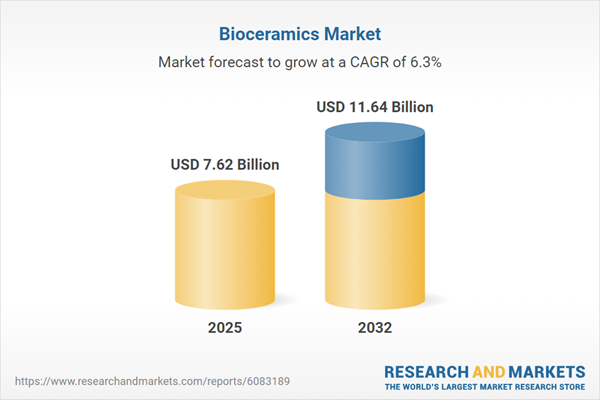Speak directly to the analyst to clarify any post sales queries you may have.
The bioceramics market is undergoing rapid transformation as advancements in materials science align closely with emerging healthcare imperatives. Senior leaders are now navigating a market defined by accelerating technological adoption, strategic regulatory shifts, and robust cross-sector collaboration.
Market Snapshot: Bioceramics Industry Growth and Prospects
The global bioceramics market grew from USD 7.16 billion in 2024 to USD 7.62 billion in 2025 and is projected to sustain a CAGR of 6.25%, reaching USD 11.64 billion by 2032.
This expansion reflects a convergence of next-generation materials, dynamic clinical needs, and ongoing regulatory evolution, establishing new benchmarks for innovation and patient care.Scope & Segmentation of the Bioceramics Market
- Product Types: Includes alumina, bioactive glass, composites (ceramic, metal, polymer matrix), hydroxyapatite, tricalcium phosphate, and zirconia materials.
- Composites: Spans ceramic matrix composites (alumina, hydroxyapatite, zirconia matrices), as well as metal and polymer matrix composites for enhanced performance adaptability.
- Applications: Covers bone grafts (allograft, autograft, synthetic with composite, hydroxyapatite, tricalcium phosphate, xenograft), coatings (electrochemical deposition, plasma spraying, sol-gel with dip and spin coating), dental implants (endosteal, subperiosteal, zygomatic), orthopedic implants (joint replacement including hip, knee, shoulder; spinal and trauma fixation), and tissue engineering (drug delivery systems, nanostructured, porous, 3D-printed scaffolds).
- Regional Coverage: Americas (including United States, Canada, Mexico, Brazil, Argentina, Chile, Colombia, Peru), Europe, Middle East & Africa (including UK, Germany, France, Russia, Italy, Spain, Netherlands, Sweden, Poland, Switzerland, UAE, Saudi Arabia, Qatar, Turkey, Israel, South Africa, Nigeria, Egypt, Kenya), and Asia-Pacific (including China, India, Japan, Australia, South Korea, Indonesia, Thailand, Malaysia, Singapore, Taiwan).
- Technology Adoption: Features rapid developments in additive manufacturing, nanotechnology, smart coatings, sol-gel techniques, and digital twin-based optimization for manufacturing.
- Company Coverage: Zimmer Biomet Holdings, Inc.; Stryker Corporation; Johnson & Johnson; Medtronic plc; B. Braun Melsungen AG; Straumann Holding AG; Dentsply Sirona Inc.; Danaher Corporation; 3M Company; GC Corporation.
Key Takeaways for Decision Makers: Strategic Insights in Bioceramics
- Clinical and technological advances are pushing bioceramics beyond traditional materials, opening new applications in regenerative medicine and implantable devices.
- Regulatory adaptations are supporting a faster translation of laboratory innovation into bedside solutions while keeping safety as a key priority.
- Increasing demand for personalized healthcare devices is driving investments in high-resolution 3D printing and nanostructured bioceramics.
- Sustainability is gaining prominence, with manufacturers adopting eco-friendly processing and sourcing approaches to lower environmental impact.
- Partnerships among suppliers, manufacturers, and clinical end-users are critical to enable seamless scale-up and accelerate commercialization of novel products.
- Operational excellence enabled by digital manufacturing, automated quality control, and real-time analytics is vital for maintaining a competitive edge in an evolving market landscape.
Tariff Impact: Navigating US Measures and Global Supply Chain Shifts
Recent U.S. tariff measures affecting bioceramic precursor materials have driven companies to reevaluate supply chain strategies, deepen regional supplier relationships, and invest in cost-efficient, low-waste manufacturing processes. The sector is witnessing increased localization and the formation of long-term supplier partnerships to mitigate tariff risks while supporting innovation and market resilience.
Bioceramics Market Research Methodology & Data Sources
This report utilizes a dual-track approach: extensive secondary research of peer-reviewed literature, patents, and regulatory filings is paired with targeted interviews of material scientists, surgeons, and industry leaders. Rigorous data triangulation and expert panels validate findings, while advanced analytics underpin market sizing and scenario modeling.
Why This Report Matters: Decision-Ready Intelligence for Senior Leaders
- Enables strategic clarity by offering detailed insights into current and emerging product, technology, and regional opportunities in the bioceramics industry.
- Equips organizations to proactively address supply chain challenges and regulatory dynamics, reducing lead-times and supporting sustainable growth.
- Supports forward-looking investment and partnership decisions by benchmarking key players and next-generation technologies.
Conclusion: Towards Sustainable Innovation and Growth in Bioceramics
The bioceramics landscape is defined by the interplay of innovative materials, evolving healthcare demands, and regional market shifts. Leaders equipped with this actionable intelligence can confidently navigate the next decade of opportunity in clinical and commercial applications.
Table of Contents
3. Executive Summary
4. Market Overview
7. Cumulative Impact of Artificial Intelligence 2025
Companies Mentioned
The companies profiled in this Bioceramics market report include:- Zimmer Biomet Holdings, Inc.
- Stryker Corporation
- Johnson & Johnson
- Medtronic plc
- B. Braun Melsungen AG
- Straumann Holding AG
- Dentsply Sirona Inc.
- Danaher Corporation
- 3M Company
- GC Corporation
Table Information
| Report Attribute | Details |
|---|---|
| No. of Pages | 181 |
| Published | October 2025 |
| Forecast Period | 2025 - 2032 |
| Estimated Market Value ( USD | $ 7.62 Billion |
| Forecasted Market Value ( USD | $ 11.64 Billion |
| Compound Annual Growth Rate | 6.2% |
| Regions Covered | Global |
| No. of Companies Mentioned | 11 |









